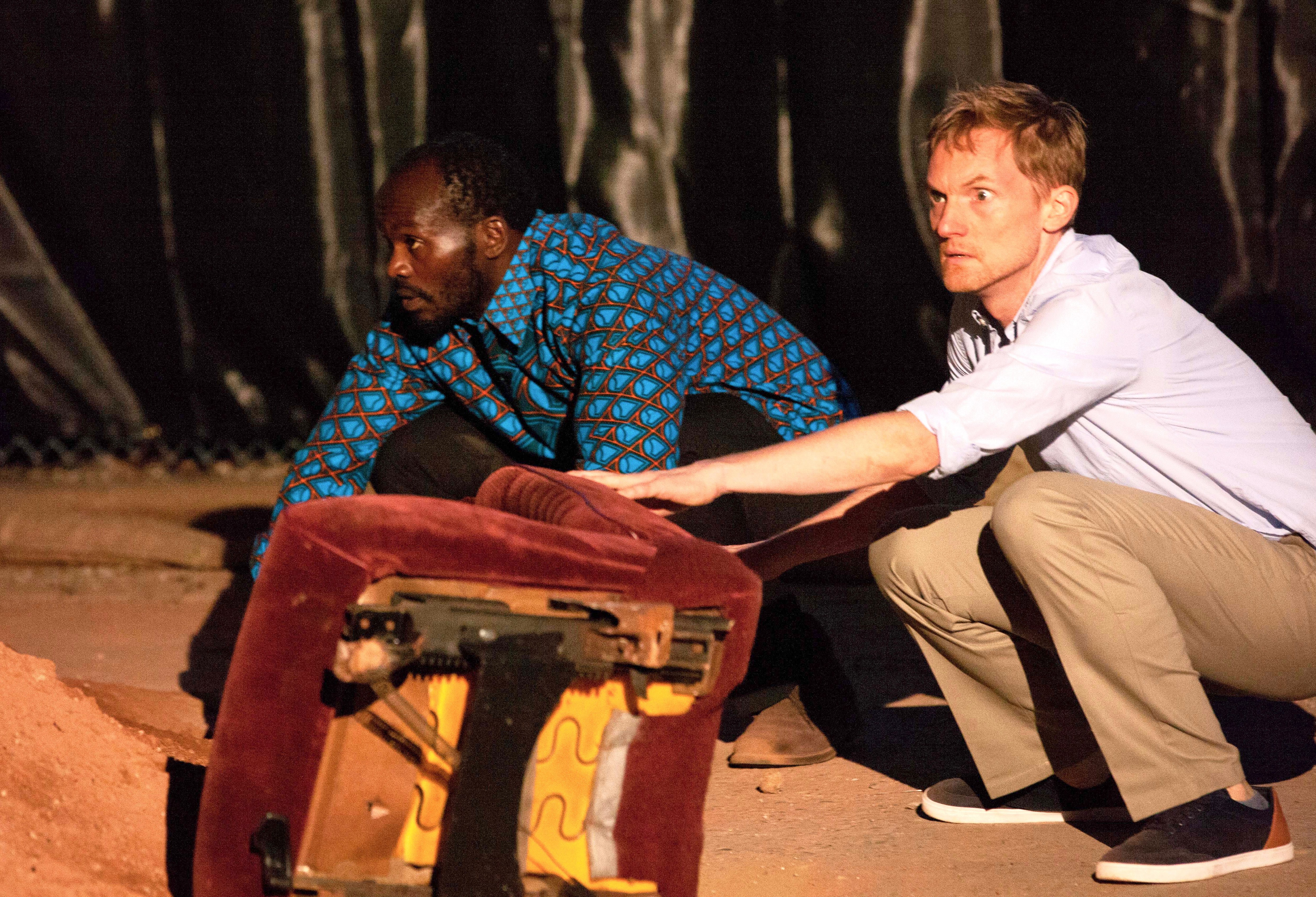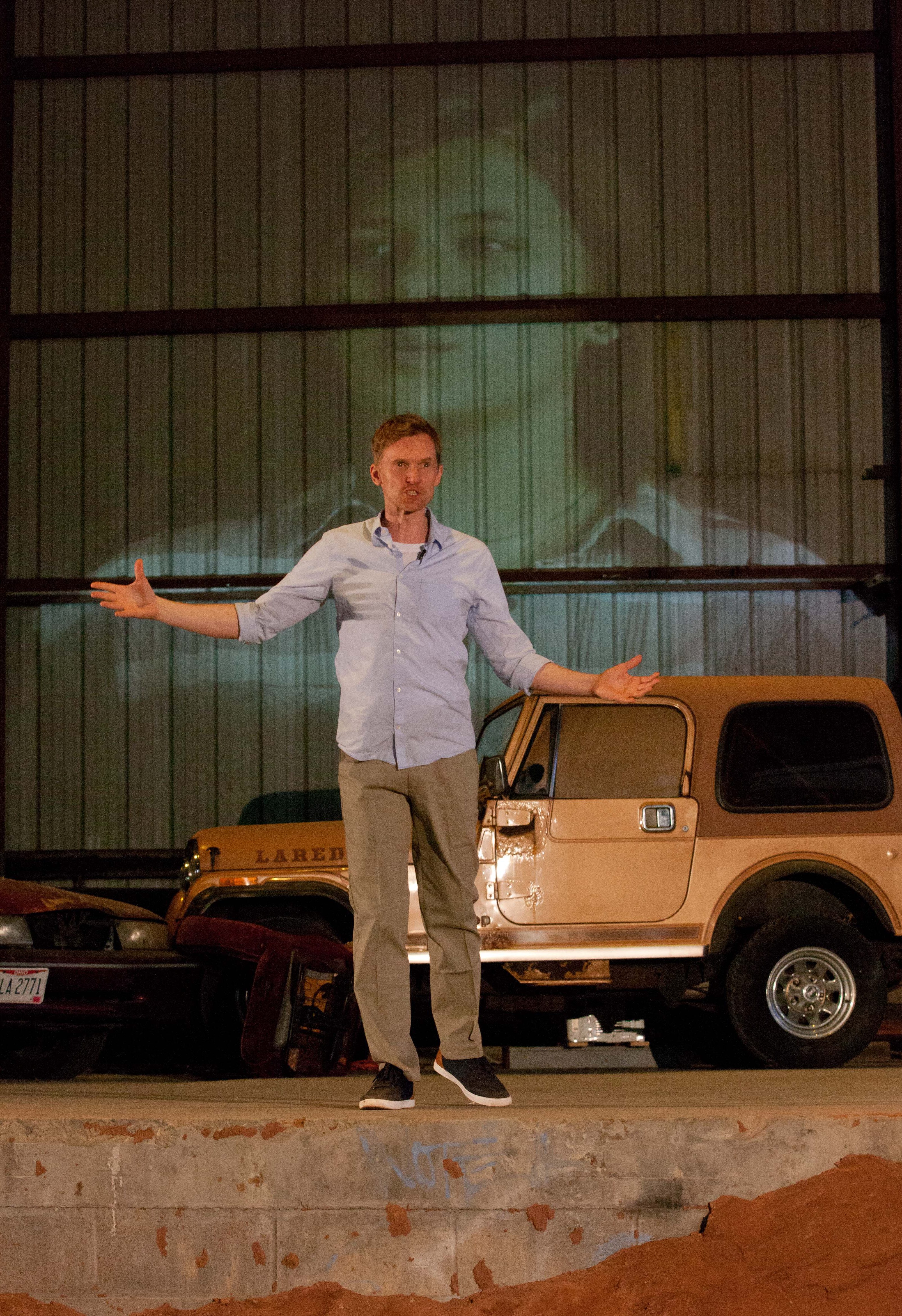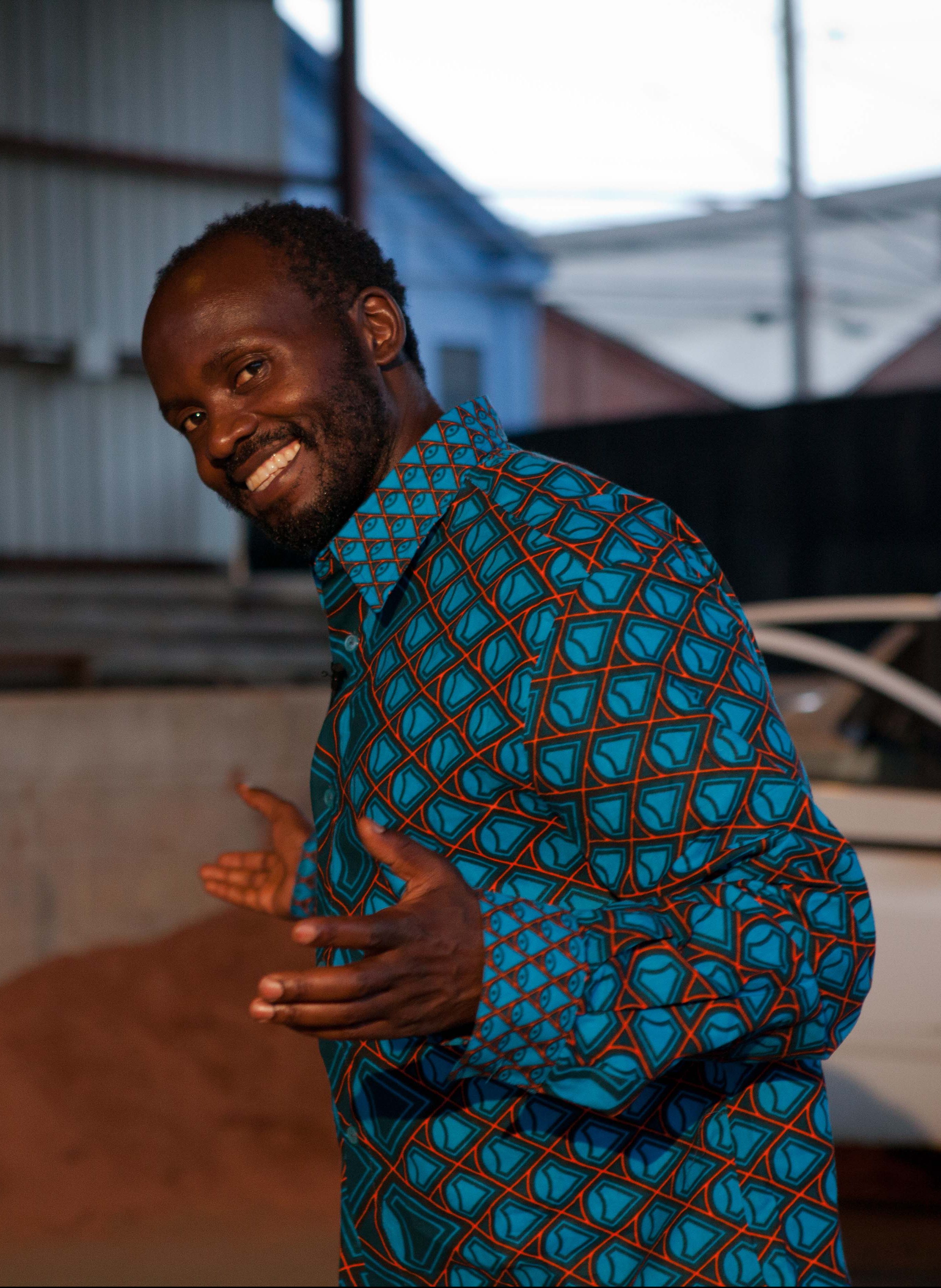Quantum Goes for Big Theme, Big Effects with ‘Red Hills’

Can you have good times re-living the bad times? God’s Blessing (Patrick J. Ssenjovu, L) and David (Scott Parkinson) attempt the feat, as the ghostly image of Mary (Ava Kepple) looks on from afar.
Quantum Theatre is a company that goes for the knockout punch every time. You won’t find any “safe” plays on the Quantum schedule, no tried-and-true crowd pleasers, because the goal is not to send the audience home saying “Well, that was nice.” The goal is to blast artistic sensibilities into new dimensions—or in some cases to stretch them there, ever so subtly, in an extended sort of TKO—and the typical audience reaction is more like “Whoa, what was that?!”
So it is with Quantum’s latest. Red Hills (through Sept. 10), co-produced with En Garde Arts of New York, is the world premiere of a new work by American theater artist Sean Christopher Lewis.
Although Red Hills has a surprise ending, which sneaks up on you, there’s not much that is quiet or subtle about it. This is a big play in every respect. Staged in a cavernous semi-building—actually, a gigantic and partly open metal shed—on the fringes of the Strip District’s former industrial zone, it’s been given a spectacular setting.
And Red Hills takes on a big subject: the Rwandan genocide of 1994. That staggering tragedy Is described and acted out, in flashback, by two (fictional) characters who were first-hand witnesses, an American and a Rwandan.
Did the play floor me? Not quite, for reasons I’ll get to. But it did leave clusters of audience members standing in a nearby parking lot and talking about it, with engrossed animation, for a long while afterward. Consider the “Whoa, what was that?!” mission firmly accomplished.
If you’re not familiar with the facts behind the Rwandan genocide, Red Hills will fill you in. But following is a brief review for those who may wish it.
Where is Rwanda and What Happened There?
Rwanda, in the central African high country, is an awesomely beautiful land of mountains and valleys. Currently home to about 11 million people, it was for centuries a feudal monarchy built around farming and cattle-raising. The king and ruling class were members of a minority social caste, the Tutsi, while the rest identified with a much larger group, the Hutu. Relations between the groups were not always cordial but generally peaceful, and there were degrees of social mobility: for instance, a Hutu who accumulated wealth and cattle could essentially “become” a Tutsi.
Then came European colonizers—first Germans, then Belgians, who administered the region from 1916 to ’62. Initially the Belgians favored and ruled through the Tutsi elite. They also began the fateful practice of requiring all Rwandans to carry racial ID cards classifying them as Tutsi, Hutu, or otherwise.
Not surprisingly, the Hutu majority chafed. In 1959 they rebelled. And Belgian authorities relented, setting up elections that moved Rwanda to independence as a democratic republic in 1962. The Hutu took control in those elections but the troubles were far from over. Amid internal strife, many Tutsi fled across the borders into neighboring countries. From there, they launched raids back into Rwanda, which grew to full-scale civil war in 1990.
By 1993, with many on both sides weary of fighting, peace accords were signed and the country seemed finally on the way to shared harmony. Sadly, this was not yet to be. Radical Hutu factions in the government and military had formed a “Hutu Power” movement aimed at deciding things in their favor permanently.
The mass killings began in April 1994, starting from the capital city of Kigali and spreading country-wide. Prominent Hutu moderates (those who’d been working for coexistence) were among the first to die. Army troops and militias manned roadblocks and swept through neighborhoods, shooting anyone who showed a Tutsi ID card. In rural areas, where machetes were common tools, Hutu civilians were told to cut down their Tutsi neighbors or be cut down themselves. You can learn further horrifying details by reading—or by attending Red Hills.
In retrospect, it seems evident the carnage was well planned. But it broke out suddenly and proceeded very rapidly, in an atmosphere of chaos. By the time Tutsi forces re-mobilized to secure the country just three months later—bringing a tenuous (and, to this date, ongoing) peace at last—an estimated one million Rwandans had been slaughtered.
The Professor and the Tour Guide
Now meet the characters of Red Hills, seen 20-some years after the fact. David (played by Scott Parkinson) is an American professor who was visiting Rwanda as a teenager on a church mission when the violence erupted. God’s Blessing (the Ugandan actor Patrick J. Ssenjovu) was a teenaged Tutsi fleeing the havoc and searching, in vain, for his parents.
David and his young girlfriend Mary (Ava Kepple, who appears only in ghostly projections on the back wall of the set) had met God’s Blessing and followed him on his desperate journey. After some hair-raising close calls, all three survived, though all were deeply marked by the experience.

The men re-enact a close call in which they watched, but weren’t caught by, the brutality of the genocide.
As noted above, these harrowing scenes are done in flashback. We learn that in the present, David has become a U.S. academic specializing in the multicultural study of transgression and forgiveness. Moreover, having gone into therapy to deal with the demons of his Rwandan memories, he’s decided to confront them by writing about them. His book is a best-seller.
But then he returns to Rwanda on the invitation of God’s Blessing, who insists that the book contains certain “untruths.” And what could those untruths possibly be? Ah, therein lies the story.
God’s Blessing—whose therapy has consisted of escorting white tourists around Rwanda in a dilapidated old sedan—takes his chum on a guided tour of the flight path they followed many years before. It’s in the course of this trip down memory lane that old escapes are re-enacted and much is revealed.
There’s plenty of action in Red Hills, and plenty of interpersonal tension too. David, at first, comes across as a near-stereotype of the well-meaning but overly privileged American trying to understand things he really can’t grasp. (At times I was reminded of the naïve Mormon missionaries in The Book of Mormon.) God’s Blessing, who not only saw but lived the grim realities, is alternately jovial and angry with his benighted buddy while trying to set the guy straight.
As the play develops, both characters become richer and fuller. The surprise ending, when it unfolds, is a stirring one indeed.
Two Beefs (and Some Plaudits)

David sees the depths; does Mary see the light?
So why didn’t Red Hills knock me totally for a loop? One reason, for me, lay in the script. Until the surprise ending—which of course can’t be revealed till the end—I sometimes had trouble fathoming the source(s) of the Rwandan’s deep agitation at the “untruths” he had found in the American’s book. This might be addressed in revisions; remember the play is a world premiere.
The other obstacle, for me, was the sheer scale of the production. In some ways the setting is a strength. The abandoned shed with its 40-foot-high roof and piles of sand and wreckage strewn about serves vividly as a replica of a haunted, violence-torn landscape. But it’s almost too big for true terror and tension to be registered.
If you’ve ever been held at gunpoint (which I have) or been the victim of serious violence (which I haven’t), you know that terror lives in immediacy. It’s so damned close that you can taste it and feel it in your skin.
Likewise, interpersonal tension boils up most strongly in situations of intimacy. You can’t bear the other person’s close presence.
And for me, personally, the play’s efforts to evoke both types of feelings were diluted, or—what’s the word?—evaporated somewhat, amid the vast space of the shed. The actors must even wear wireless headset mics to help their voices be heard, which is OK for musical theater but leaves these characters speaking loudly at each other during times when a stage-whispery exchange or a silent glance might do better.
That said, the actors are good. Parkinson, as David, transcends his early academic-geek persona, actually appearing to grow stronger and more muscular as the play moves along. Ssenjovu, as God’s Blessing, is an engaging dynamo throughout. Kepple’s projected-image scenes as girlfriend Mary have a nicely controlled power.

Welcome to my world, says God’s Blessing, whose stories include the origin of his distinctive name.
And altogether, Red Hills is the kind of production we count on Quantum to deliver. Big new stuff done boldly. Whether it knocks you out or just gets you talking and thinking, you ought to give it a try.
Closing Credits and Ticket Info
Sean Christopher Lewis’ Red Hills, a coproduction of Quantum Theatre and En Garde Arts of New York, is directed by Katie Pearl with scenic design by Deb O. Through Sept. 10 at the corner of 32nd and Smallman Sts., Strip District. For show times and tickets visit Quantum on the web or call 412-362-1713.
Photos by Heather Mull.
Mike Vargo, a Pittsburgh-based freelance writer, covers theater for Entertainment Central.
Share on Social Media
Follow Entertainment Central
Latest Stories
Sign up for the EC Newsletter







